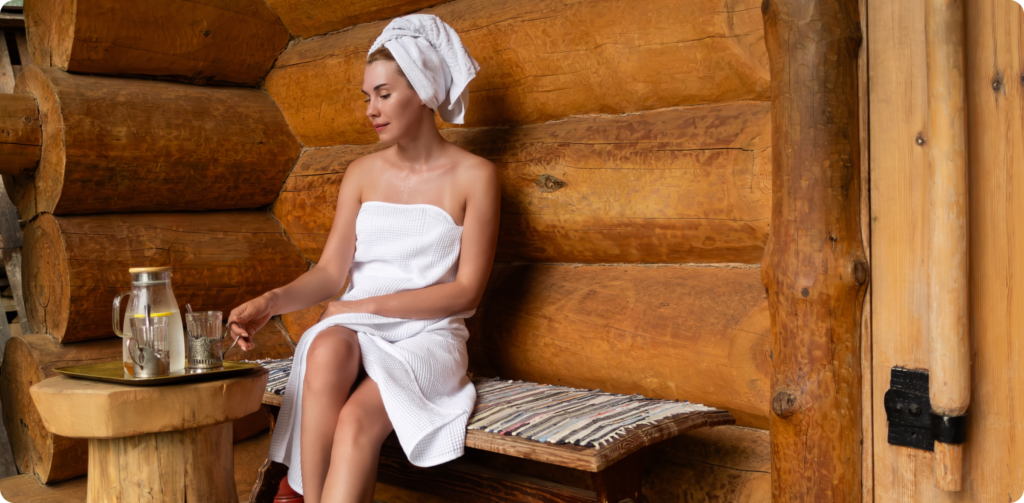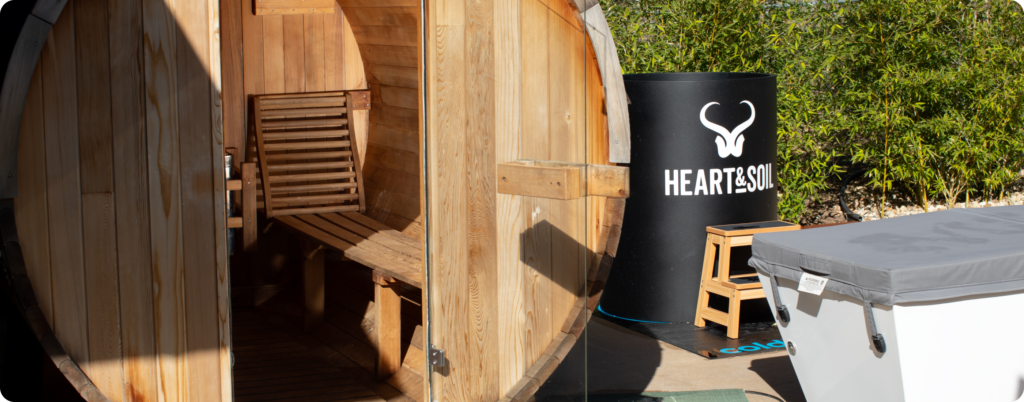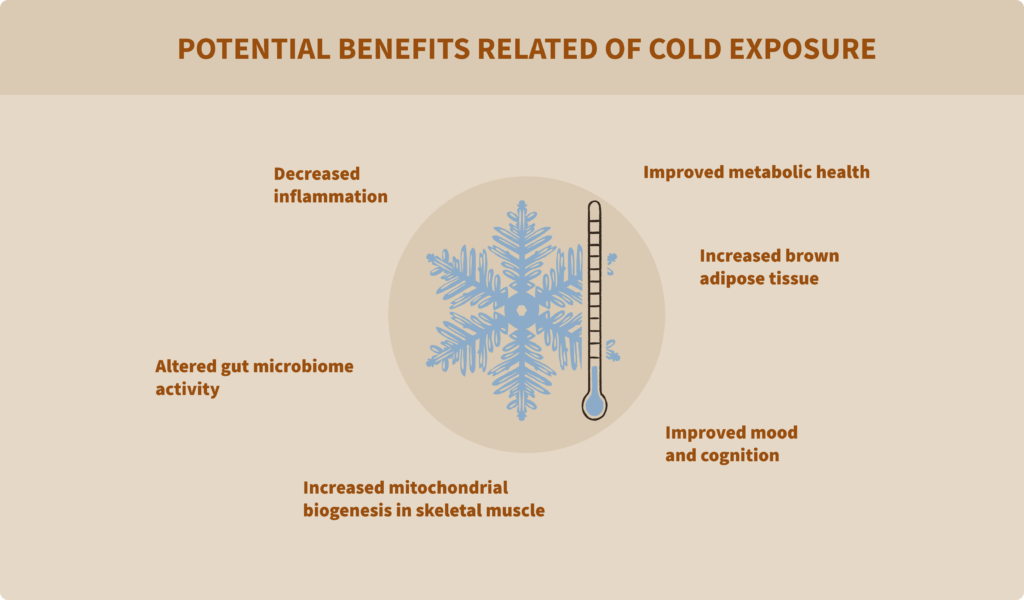PLEASE NOTE: The information in this blog is for educational purposes only. It is not a substitute for professional medical advice. Consult your healthcare provider if you’re seeking medical advice, diagnoses, or treatment.
Reduced blood pressure, improved mood, reduced inflammation, and increased longevity. These improvements sound pretty great, don’t they?
What if you can get these benefits just by exposing your body to extreme heat and cold? These practices are thousands of years old, and modern science is just beginning to understand their benefits.
This article will walk you through the cold plunge and sauna health benefits, as well as how to safely implement these into your routine.
Off we go!
Sauna Health Benefits: Why It’s Been Used For Thousands of Years
From Roman Baths to Aboriginal sweat lodges and Scandinavian saunas, heat exposure has been used for thousands of years to improve hygiene, form social bonds, and bolster health (1, 2).

Sauna use, in particular, has lasted the test of time and is still used globally. The sauna (a Finnish word) refers to a spruce or pine-paneled room with wooden benches (3). Depending on the type of sauna, temperatures usually range from 113 °F to 212 °F.
There are many potential sauna benefits to be aware of, such as (4, 5):
- Reduced inflammation & stress
- Detoxification of heavy metals and other contaminants
- Building community & friendships
- Enhanced levels of growth hormone
- Improved endurance & recovery
- Improved longevity
- Reduced risk of cardiovascular disease
Let’s take a closer look at each of these 10 sauna health benefits:
1. Reduced Symptoms of Depression.
Depression is the leading disability worldwide, and the sauna has been proven to improve depression symptoms (6, 7). The sauna has also been shown to reduce anxiety and improve mood (8).
2. Improved Longevity.
Maybe one of the most compelling benefits of regular sauna bathing is the potential to extend health span (9), which refers to the time one spends in a state of health.
Regular use of the sauna may reduce the risk of dozens of significant health challenges, such as (10, 11):
- Hypertension
- Cardiovascular disease
- Lung conditions such as asthma and COPD
- Stroke
- Dementia
- Musculoskeletal disorders such as rheumatoid arthritis and osteoarthritis
To add even more intrigue to the topic of heart health, a major study from Finland showed that men who used the sauna 2-3 times per week had a 27% lower risk of dying from cardiovascular disease than men who used the sauna once a week (12).
Those who used the sauna 4-7 times per week had a 50% lower chance of CVD mortality. This same study found that frequent sauna use may have reduced the risk of developing Alzheimer’s and dementia.
So, the sauna may be a powerful tool to help you lead a long, healthy life!
3. Reduced Inflammation.
Inflammation is closely connected to chronic disease development (13, 14). While inflammation is a critical process for your body, chronic low levels of inflammation can contribute to various diseases.
One of the leading indicators of inflammation is a blood marker called C-reactive protein (CRP). Studies have shown that as sauna usage increases, CRP levels decrease (15).
4. Stress Reduction.
Everyone experiences some level of stress daily. However, stressors such as exercise or the sauna can actually help you respond better and reduce stress (16).

There’s a phenomenon known as hormesis, where small amounts of a stressor can actually benefit health and lifespan as a multitude of protective mechanisms are sprung into action (17).
5. Detoxification of Contaminants.
Most humans are constantly in contact with environmental toxins such as heavy metals, phthalates, and pesticides (18). This can spell trouble for your health. Elements such as lead, arsenic, and cadmium can exert toxic effects on the nervous, cardiovascular, and endocrine systems (19).
Thankfully, many of these toxins, such as bisphenol A (BPA), pesticides, and phthalates, can be eliminated by sweating (20). When exposed to intense heat, the body creates heat shock proteins, which can help degrade and transport toxins out of the body (21). Heavy metals can also be excreted with the help of exercise (22).
6. Growth Hormone Production.
Being in the sauna leads to the release of growth hormone (23). When paired with exercise, the growth hormone release can be even greater (24).
Why does this matter? Growth hormone supports the growth of nearly every organ and tissue in the body and can prolong the lifespan of cells (25).
7. Improvements in Autoimmune Symptoms.
The sauna may also help with certain autoimmune conditions. For example, the infrared sauna was shown to benefit patients with ankylosing spondylitis and rheumatoid arthritis (26, 27). Sauna bathing may also assist psoriasis patients (28).
8. Improved Endurance.
Regular sauna usage can benefit athletes due to heat acclimation (29).

One of the potential sauna health benefits is improved endurance as it’s been shown to improve cardiovascular function (30). Another study of distance runners showed that using the sauna after exercise improved running performance in as little as 3 weeks (31).
9. Accessibility.
Another benefit of sauna usage is it can be easily used to produce anti-inflammatory cytokines by those who are physically inactive, injured, or looking to detox (32).
10. Community & Relationships.

One of the sauna health benefits that’s easy to overlook is the community. Saunas are typically public and act as a form of social gathering to talk about family, books, or current events while engaging in a challenging activity. This can lead to friendships and ease feelings of isolation (33).
Sauna Risks: What You Should Know
Sauna health benefits are wide-ranging and generally considered safe, but there are risks to be aware of.
First, avoid consuming alcohol in conjunction with sauna usage as it increases the risk of sudden death, severe dehydration, stroke, arrhythmia, and hypotension (34, 35).
Hydration and electrolyte balance are other important considerations. About 0.5kg of fluid, along with potassium, sodium, magnesium, and calcium (36), can be lost in a single sauna session. Before and after a sauna session, be sure to consume electrolyte-rich foods and beverages such as dairy, coconut water, and fruits.
While saunas can be safe to use for those with stable cardiovascular conditions, you should always speak with a medical professional before using a sauna (37, 38).
Saunas are widespread in Finnish countries and are considered safe for a healthy pregnancy. Still, it’s suggested that you speak with a medical professional to ensure it’s safe for your specific circumstances (39, 40).
With all that said, how often should you use the sauna? The sweet spot for sauna usage appears to be about 3-7 weekly sessions at 15-20 minutes each (41).
The Powerful Benefits of Cold Exposure
Cold exposure is an ancient practice that’s regaining popularity in the form of cold plunges, cold water swimming, or cryotherapy due to numerous potential benefits.

Potential benefits of cold exposure include:
1. Weight Loss Support.
Mammals have four different types of fat—brown, white, pink, and beige—to provide insulation, store energy, and perform other important functions (42). Properly functioning adipose tissue is a key to metabolic health (43).
Brown adipose tissue (BAT), in particular, has emerged as a tool against obesity, and cold exposure is one of the foremost methods to activate brown adipose tissue (44)(45).

Daily cold exposure can increase the volume of brown adipose tissue (46). Cold exposure (and exercise) can also contribute to the formation of beige fat, protecting against obesity and other complications (47).
2. Mood & Mental Health Improvements.
Regular cold-water swimming has shown a positive impact on well-being, reducing depressive symptoms, improving mood, and even reducing fatigue (48). Exposure to cold can also lead to the release of serotonin, dopamine, and other neurotransmitters that contribute to the regulation of stress and emotions (49).
3. Improved Immune Function.
Hippocrates used cold exposure to help treat serious illnesses, and cold exposure may improve immune system function (50).
A 2016 randomized control trial had participants incorporate regular physical activity and cold showers into their daily routine. This combination resulted in over a 50% decrease in sick days taken at work compared to those who didn’t make these changes (51).
4. Recovery After Exercise.
Cold water immersion is effective in managing sore muscles (52). Swimming in cold water has also been shown to help relieve pains associated with asthma, fibromyalgia, and rheumatism (53).

Despite these benefits, it’s important to remember that the benefits of cold exposure may be explained by other factors, such as a healthy diet, an active lifestyle, or the use of stress management techniques (54). This is known as the healthy user bias.
Are There Any Risks to Cold Exposure?
While cold exposure has numerous benefits, it does require some caution. We always suggest speaking with a medical professional before participating in cold exposure.
Extreme cold temperatures can lead to hypothermia, where your internal body temperature drops below 95 degrees, or frostbite in extreme cases.
Similar to the sauna, you should avoid alcohol consumption when engaging in cold exposure as it may increase the likelihood of adverse events.
It’s also common to alternate between sauna sessions and a cold plunge. When doing so, it’s possible to have unsafe changes in blood pressure (55). If you’re doing a cold plunge in a lake, ocean, or other body of water, ensure that you have someone nearby to assist you if anything goes wrong.
Another consideration before cold plunging is your stress levels, as the impact of cold exposure on stress hormones can depend on the individual (56). For some, the added stress of a cold plunge may do more harm than good.
Sauna & Cold Exposure: Ancient Practices With Enormous Benefits
Simple lifestyle adjustments can dramatically impact your health. Sauna use and cold exposure are perfect examples.
While uncomfortable at times, they can improve cardiovascular health, athletic performance, and detox contaminants. Many also use these strategies for pain relief, stress relief, improved skin health, or to fight illness.
Health trends come and go, but cold exposure and sauna bathing have stood the test of time.
Subscribe to future articles like this: